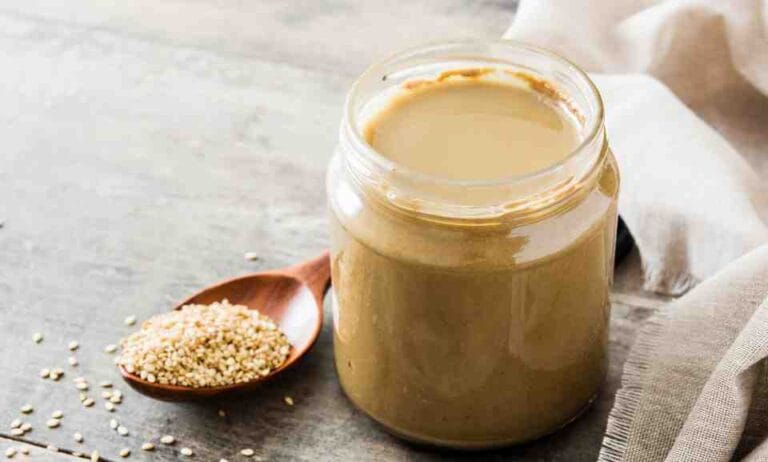Tahini, a paste made from ground sesame seeds, is a popular ingredient in many Middle Eastern and Mediterranean dishes. Known for its rich, creamy texture and slightly nutty flavor, tahini is not only delicious but also packed with nutrients that offer various health benefits. In this article, we’ll explore the health benefits and properties of tahini, as well as how to incorporate it into your diet.
What is Tahini?
Tahini is made by grinding roasted or raw sesame seeds into a smooth paste. It is commonly used in dishes like hummus, salads, and dressings, as well as in desserts. Sesame seeds, the main ingredient, are highly nutritious, which makes tahini a great source of essential nutrients like healthy fats, protein, and vitamins.
Health Benefits of Tahini
- Rich in Healthy Fats
Tahini is a great source of healthy fats, particularly polyunsaturated and monounsaturated fats. These types of fats are beneficial for heart health, as they can help reduce levels of bad cholesterol (LDL) while promoting good cholesterol (HDL). Consuming healthy fats regularly can also contribute to better brain function and overall well-being.Benefit: Tahini supports heart health and provides essential fatty acids for optimal brain function. - High in Protein
Tahini is an excellent plant-based source of protein, which is essential for muscle growth, repair, and overall body function. Protein is also crucial for the production of enzymes and hormones that regulate various body processes.Benefit: Tahini can be an important protein source, especially for vegetarians and vegans. - Packed with Minerals
Tahini is rich in several important minerals, including calcium, iron, magnesium, and zinc.- Calcium is essential for bone health and muscle function.
- Iron helps prevent anemia and supports oxygen transport in the blood.
- Magnesium plays a key role in muscle and nerve function, as well as maintaining healthy bones.
- Zinc supports immune function and wound healing.
- Good Source of Antioxidants
Sesame seeds, the primary ingredient in tahini, are rich in antioxidants like sesamin and sesamol, which help protect the body from oxidative stress and free radical damage. Antioxidants are crucial for reducing the risk of chronic diseases such as cancer and heart disease.Benefit: Tahini’s antioxidants protect against cell damage and support long-term health. - Supports Digestion
Tahini contains a good amount of fiber, which aids in digestion and helps maintain a healthy gut. Fiber promotes regular bowel movements, prevents constipation, and supports overall digestive health.Benefit: The fiber in tahini helps keep your digestive system functioning smoothly. - Promotes Healthy Skin
The high content of healthy fats and antioxidants in tahini helps nourish and hydrate the skin. These properties can reduce signs of aging, such as fine lines and wrinkles, and improve overall skin appearance.Benefit: Tahini contributes to healthy, glowing skin by providing essential fatty acids and antioxidants. - Supports Bone Health
Tahini is a rich source of calcium, an essential mineral for maintaining strong bones and preventing osteoporosis. It also contains magnesium, which works with calcium to help improve bone density.Benefit: Regular consumption of tahini supports bone strength and may help prevent bone-related conditions.

How to Use Tahini
- In Salads and Dressings
Tahini can be used as the base for creamy salad dressings. Simply mix it with lemon juice, olive oil, garlic, and a bit of water to achieve a smooth and flavorful dressing. - In Hummus
Tahini is a key ingredient in traditional hummus. Its creamy texture and nutty flavor make hummus richer and more satisfying. Blend tahini with chickpeas, garlic, olive oil, lemon juice, and spices to create a delicious dip. - In Smoothies
Add a spoonful of tahini to your smoothie for an extra boost of protein and healthy fats. It pairs well with fruits like bananas and berries, and it complements the flavor of chocolate and vanilla. - As a Spread or Topping
You can spread tahini on toast or drizzle it over vegetables, grains, or roasted meats. It can also be used as a topping for pancakes, waffles, or baked goods. - In Baking
Tahini can be used as a substitute for butter or oil in certain baking recipes. It adds a nutty flavor and a smooth texture to baked goods like cookies and cakes. - In Desserts
Tahini is often used in Middle Eastern and Mediterranean desserts. You can combine it with honey or maple syrup for a simple, delicious sweet treat. It’s also used in energy balls, granola bars, and other homemade snacks.
How to Choose the Best Tahini
When buying tahini, look for organic and minimally processed varieties that contain only sesame seeds, without added sugar or preservatives. The texture should be smooth and creamy, and the color should be light to medium brown. Avoid tahini that has an off or rancid smell, as this could indicate that it has gone bad.
Conclusion
Tahini is a highly nutritious food that offers a wide range of health benefits, from promoting heart health and supporting digestion to improving skin appearance and providing essential minerals. It’s versatile, delicious, and easy to incorporate into your diet in a variety of ways. Whether you’re using it as a dressing, in dips, or as a spread, tahini can be a great addition to your meals for both its flavor and its nutritional value.



